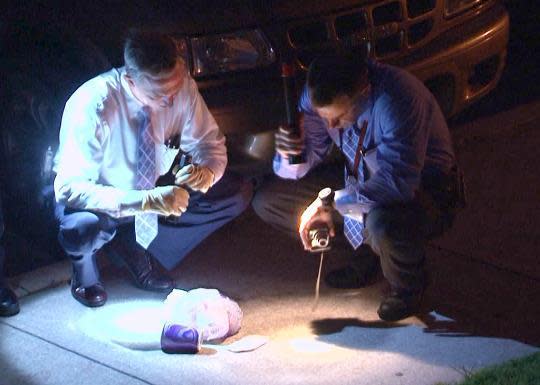'The First 48': Deviously Addictive True-Crime TV

On Monday night, A&E will showcase First 48: Deadly Misfortune, the latest offshoot of the channel’s popular true-crime franchise. If, like me, you are intrigued by true-crime drama — I like reading and watching some of the better examples of the genre, for sure — The First 48 can be addictive entertainment.
Of course, you’re supposed to feel guilty saying you “enjoy” a TV show about heinous murders, but there’s nothing guilty-pleasure-y about watching a show like The First 48, which first premiered in 2004. It’s got a great hook — in an hour show, two unrelated cases are followed for the first 48 hours of investigation, the well-known timeframe that has been commonly deemed by law enforcement to be the most crucial in gathering clues and cracking the case.
The First 48 keeps a running clock going on each episode, and, when combined with the gritty, subtly tense narration by Dion Graham (fans swoon when he says stuff like, “The investigator gets an unexpected call that turns the case on its head!”), lends this series a propulsive narrative pace.
The cases First 48 follows tend, over time, to take on a certain devious pattern. They’re most often killings that occur in poor neighborhoods, often in and around dank motels and alleys. The victims and perpetrators are frequently black or Hispanic. One result is that white viewers who don’t live in some of the First 48 hotspots — Miami and Las Vegas are two favorite shooting locations for the series — can loll back in their Laz-E-Boys in, say, Rhode Island or Oregon and think, Man, I’m glad I don’t live there. Another conclusion a viewer can reach is that poverty certainly leads to an awful lot of tragedy.
The First 48 has attracted a certain amount of controversy as well. Sometimes what’s shown on camera as a successful apprehension turns out, when the cameras have been turned off, to be a false arrest, or one obtained through inaccurate evidence, or faulty law-enforcement procedure that gets thrown out of court. By far the most extensive investigation into The First 48’s sometimes-expedient methods is Terrence McCoy’s long and fascinating piece, “The First 48 Makes Millions Off Imprisoning Innocents,” that appeared in a January issue of the Miami New Times. I urge you to read it.
One other bit of deviousness — a bit of programming slight-of-hand: The episodes of The First 48: Deadly Misfortune that show up this week in your TV listings aren’t actually new episodes. They’re re-edited versions of cases that previously aired, with fresh updates.
I freely admit that none of these varying degrees of sneakiness is going to prevent me from watching The First 48 now and then. I watch for the colorful characters on both sides of the law, for the intriguing details of police investigation, and for quotes like this, from a cop waving around a silver-plated .50 caliber Desert Eagle pistol that turns up as homicide evidence: “I haven’t seen that gun since the 1980s; there’s only one use for it: killing people.”
There’s an argument for stricter gun-control law right there, isn’t it?
The First 48 airs on A&E; check your local listings.


